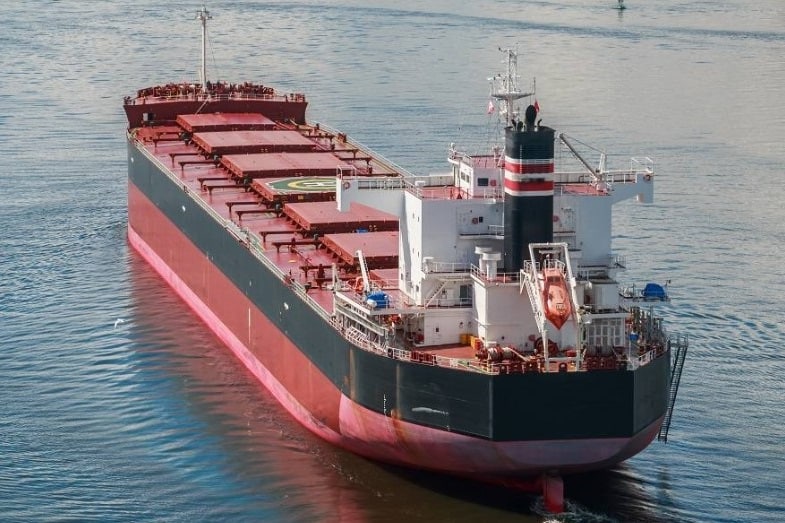The size and bulk of a modern-day cargo ship can inspire awe and admiration when seen up close. They are designed to carry a massive amount of cargo for long distances across the world’s oceans. In this article, I’ll address how much a cargo ship weighs, including its average carrying capacity.
How much does a cargo ship weigh? A large cargo ship that measures 1,400 feet long by 200 feet wide (425 meters by 60 meters) has an approximate deadweight of 220,000 tons. This is about as heavy as Chicago’s Sears Tower!
A large cargo ship can carry a maximum of 23,756 TEUs (Twenty-Foot Equivalent Units). As of 2010, about 9,535 container ships of this size, or near it, are traveling trade routes worldwide.
Read on to learn more about how much a cargo ship weighs and the average weight of the 10 biggest cargo ships in the world.
How Much Does a Cargo Ship Weigh?
An estimate made in 2011 about the weight of a cargo ship pegged the number at 220,000 tons deadweight (DWT). The container ship would be about 440 meters by 59 meters. This ship’s capacity is up to 23,756 TEUs. In 2010, it was estimated that around 9,535 cargo ships were traveling across the world’s oceans. [1]
There are two classes of modern containers used today. The first one is the twenty-foot equivalent unit (TEU), and the second is the forty-foot equivalent unit (FEU). FEU is simply two TEU containers combined.
The terms TEU and FEU are the international standards used in cargo shipments. These terms are used to facilitate the transport of cargo by various container ships from different manufacturers.
When they were built, the typical cargo ships can only carry a few hundred TEUs or 20-foot containers. Shipbuilders only started to make cargo ships that can carry 1,000 TEU containers in the late 1960s.
What Is the Average Weight of Cargo Ships?
Cargo ships are different from each other, even those in the same class and built by the same manufacturer. There would be some differences here and there. It is the reason why it is difficult to determine the standard weight of container ships. However, it is not wrong to say that there is an average weight of container ships.
So, how much does a cargo ship weigh? The “average” weight of merchant ships during the Second World War was about 6,000 tons to 10,000 tons. Some ships weighed less than 6,000 tons. No ships weighed more than 10,000 tons at that time.
Modern cargo ships are much bigger. They now have an “average” deadweight ton of 100,000 tons. There are still “smaller” container ships that weigh about 50,000 tons. However, there are also bigger cargo ships that weigh over 200,000 tons.
In today’s merchant shipping, tankers start at 100,000 tons and can go up to one-half million tons. But some in the container shipping industry believe that it is difficult to get an average weight of the different ships built by various shipbuilders. To them, it is comparing apples with oranges.
Another thing you may find interesting is the origin of the term “ton.” It is originally a derivative from the word tun, which is the term for cargoes of liquor and wine barrels way back then. A tun occupied 100 cubic feet of space. Over time, “u” was replaced with an “o,” so we now have the word “ton.” This term is now used to denote the weight of a ship, among others.
What Are the Biggest Cargo Ships in the World?

As of 2020, the list of the biggest containerships in the world has been growing. The below list ranks these ships from the smallest to the biggest, along with their TEU capacities.
1. MSC Jade
The smallest among the top 10 biggest container ships in the world belongs to the fleet of the Mediterranean Shipping Company. This ship is 398.40 m (1, 307 ft.), 59.00 m (193.57 ft.) wide, and 30.30 m (99.40 ft.) high. It has a deadweight tonnage of 199,000 tons and can carry a maximum of 19,224 TEUs.
MSC Jade is powered by a MAN B&W 11G95ME-C9.5 two-stroke marine engine. It was built by Daewoo Shipbuilding and Marine Engineering of South Korea. The ship was floated in 2016 and was delivered to its owner in May 2019. The flag of Liberia is hoisted on its mast when it travels the oceans.
2. MSC Leanne
MSC Leanne is one of the newest ships in the cargo fleet of the Mediterranean Shipping Company. This ship can carry 19,462 TEUs. Its deadweight tonnage is 172,785 tons. The ship measures 399.99 m (1,312.30 ft.), 58.80 m (192.91 ft.), and 30.20 m (99.08 ft.) high.
This cargo ship is a Pegasus-class container vessel built by Samsung Heavy Industries of South Korea. It also flies the flag of Liberia on its ocean voyages.
3. MSC Rifaya
Next on our list of the world’s top 10 largest container vessels is another MSC ship called the MSC Rifaya. It is 399.99 m (1,312.30 ft.) long with a width of 58.80 m (192.91 ft.) and a draught of 23.31 m (76.48 ft.).
It is a DNV-GL class ship that is also traveling under the flag of Liberia. This vessel has a carrying capacity of 19,462 TEUs, and its deadweight tonnage is 196,000 tons.
4. MSC Mirjam
MSC Mirjam is another ship owned and operated by the Mediterranean Shipping Company. It is another Pegasus-class container vessel. It is 399.99 m (1,312.30 ft.) long and 58.80 m (192.91 ft.) wide. It has a draught that is 23.31 m (76.48 ft.).
MSC Mirjam’s carrying capacity is 19,462 TEUs. Its gross tonnage is 194,489 tons, and it has a cruising speed of 14.7 knots. This container ship is powered by a MAN B&W 11G95ME-C9.5 two-stroke type marine engine.
5. MSC Eloane
The Mediterranean Shipping Company has another cargo vessel in the big 10. It is MSC Eloane built by South Korea’s Samsung Heavy Industries. This ship is a Pegasus-class container vessel that has a length of 399.99 m (1,312.30 ft.), a breadth of 58.80 m (192.9 ft.), and a draught of 31.31 m (102.72 ft.).
MSC Eloane has a maximum carrying capacity of 19,462 TEUs and has a deadweight tonnage of 201,869 tons. Along with its sister ships, Ingy and Diana, this ship is sailing under the banner of Liberia.
6. MSC Ingy
Another ship owned by the Mediterranean Shipping Company made it on our list of the top 10 biggest container vessels in the world. It is the MSC Ingy, a 399.99 m (1,312.30 ft.) long and 58.80 m (192.91 ft.) wide ship with a draught of 23.31 m (76.48 ft.). Its maximum carrying capacity is 19,462 TEUs.
The deadweight tonnage of MSC Ingy is 210,869, enough to make it to the big 10. This ship was floated in 2016 by Samsung Heavy Industries of South Korea in April 2016. It is now serving under the flag of Liberia and has its homeport in Monrovia.
7. MSC Diana
MSC Diana, owned and operated by the Mediterranean Shipping Company, is another one of the largest cargo vessels in the world. It boasts a deadweight of 197,708 tons and 19,362 TEUs of maximum carrying capacity.
South Korea’s Samsung Heavy Industries built this ship. It is now sailing under the flag of Liberia. The overall length of this ship is 399.99 m (1,312.30 ft.). Its beam has a width of 58.80 m (192.91ft.), and its draught is 30.20 m (99.08 ft.).
8. MOL Triumph
MOL Triumph, owned and operated by Mitsui O.S.K. Lines is the next biggest container ship in the world. It did hold the record for the biggest and heaviest cargo ship in the world before Madrid Maersk overpassed it. This ship is 400 m (1,312.34 ft.) long, 58.8 m (192.91 ft.) wide, and 32 m (104.98 ft.) high.
Samsung Heavy Industries in South Korea constructed it. It was the first 20,000 TEU ship in a fleet of six ships in MOL’s dockyard. It sailed on its maiden voyage in April 2019 and is now negotiating the trade route of Asia to Europe. MOL Triumph is propelled by MAN B&W G95ME and has a maximum cruising speed of 24 knots.
9. Madrid Maersk
Maersk Line held the previous record of operating the biggest cargo ship in the world – up until the OOCL Hong Kong was drafted into service by OOCL. However, its latest cargo ship, Madrid, is still big by today’s standards.
This ship was built by Daewoo Shipbuilding & Marine Engineering and was put in service by its owner in April 2019. The maximum carrying capacity of Madrid Maersk is 20,568 TEU containers. It belongs to the Triple E-Class vessels.
Madrid has a deadweight of 192,672 tons. Its total length is 399 m (1,312.30 ft.), and its beam is 58.8 m (192.91ft.). The ship can accommodate 23 rows of containers across its deck. A report claimed that it was built with cutting-edge equipment and facilities that can be retrofitted for conversion to LNG power in the future.
10. OOCL Hong Kong
The Chinese shipping company, Orient Overseas Container Lines, has a new ship called the OOCL Hong Kong. This container ship has a length of 399.87 meters (1,311.909 feet) and is considered an ultra-long ULCV or Ultra Large Container Vessel. It can carry a massive amount of 21,413 TEU containers and has the distinction of being the first cargo vessel that surpassed 21,000 TEUs.
This ship was built by Samsung Heavy Industries and delivered to the owner in May 2019. It has a deadweight of 197,317 tons, a beam of 58.8 m (192.9 ft.), and a depth of 32.5 m (106.63 ft.). This ship will serve the trade route of Asia to Europe.
What Is the Average Carrying Capacity of Cargo Ships?

How much does a cargo ship weigh? The deadweight tonnage indicates the actual carrying capacity of a cargo ship. It is the weight of the ship when it is fully loaded with all of its cargo. When the ship is loaded, its hull is immersed in the water, up to the ship’s draught level.
The gross tonnage of a ship, on the other hand, is the actual carrying capacity of the hull of the ship, indicated in cubic feet and divided by 100. These are the two accepted measurements of cargo vessels used in international shipping.
Let us take the example of one cargo ship, Christophe Colomb, operated by CMA CGM, a French shipping company. This ship is much larger than the usual big cargo vessels. It has the capacity to float 153,222 tons, which in terms of cargo shipping, is not that heavy.
But there are much bigger ships that can displace water in the range of 600,000 tons. Some ports cannot accommodate these huge ships. These sea vessels are called Ultra Large Crude Carriers–meaning they only carry crude oil.
If you really want to know the average carrying capacity of cargo ships, consider the following information:
- A standard 40-foot container can accommodate around 25 to 30 tons.
- An average cargo ship, around 700 feet long, can carry approximately 1,000 of these 40-foot containers
- That would be a total carrying capacity of about 25,000 tons
You could consider that figure as the average carrying capacity of cargo ships. In real-life experience, cargo ships that travel between the US West Coast and Hawaii are approximately 700 to 900 feet long. The usual weight of their cargo on board is between 15,000 to 18,000 tons.
Conclusion – How Much Does a Cargo Ship Weigh?
So, to recap, a 2011 estimate indicated that an ultra-large cargo ship that measures about 1,400 feet long by 200 feet wide (425 meters by 60 meters) has an approximate deadweight of 220,000 tons. This is about as heavy as Chicago’s Sears Tower!
As of 2010, around 9,535 container ships of this size are estimated to be in service all over the world.




